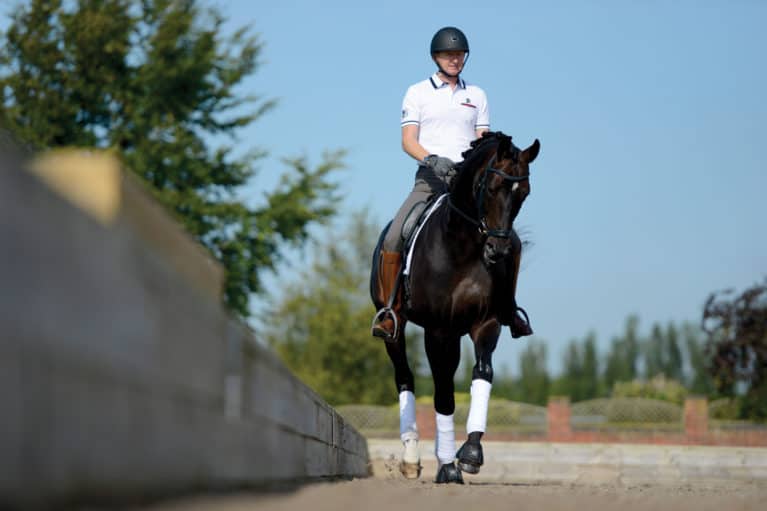Lateral movements not only look impressive, they have numerous benefits for your horse, too. Dressage rider Gareth Hughes explains a simple way to introduce them

Lateral work is important because it helps to keep your horse supple. There’s no getting away from the fact that none of our horses are getting any younger and with age comes stiffness. But if you make lateral work a regular part of your horse’s exercise programme, it’ll help to keep him supple and moving freely.
The movements can seem a bit daunting if you’re new to them, but if you break them down into manageable, bite-sized pieces, they’re achievable for anyone. Whether you’re learning lateral work yourself or introducing your horse to it, it’s advisable to introduce leg-yield first, followed by shoulder-in, then travers and finally half-pass.
Giving your horse the right idea
When you’re first introducing lateral work to your horse, you need to give him a little bit of an idea of what it is you want. It’s easy for horses to offer things without really understanding what they’re doing. However, if this is the case and they haven’t learnt the basics of each movement, when the movements get harder, cracks will start to appear.
Basically, when you introduce a new movement, make it easy – don’t worry about technical positioning, how much angle you have or how far you move across. Simply focus on very subtly asking your horse to step away from your leg while making sure you maintain balance and rhythm, and show him how to shape his body. Once he understands what you’re asking of him, then you can start working towards making it more technically correct.
Leg-yield
Leg-yield requires your horse to move forwards and sideways, with his shoulders leading, head flexed away from the direction of the movement and his body straight.
It should be introduced first, because it gets your horse used to bending around your inside leg. You can introduce leg-yield early, when horses are still young, because it gives them the first indication of how to bend round the leg and move up to the outside rein. This is important, because your horse will need to know this before you’re able to move on to the other lateral movements. This movement also helps to keep your horse supple, so is good for horses at all stages of training.
The aids
- apply your inside leg on or slightly behind the girth to push your horse over
- move your outside leg behind the girth to keep him straight and maintain forward movement
- take a gentle feel on your inside rein to ask for a little flexion to the inside – you should just be able to see your horse’s nostril
- support your horse with your outside rein to prevent him falling out through his outside shoulder
Introducing leg-yield
Turn down the three-quarter line in rising or sitting trot and ride straight. Move your horse’s shoulders slightly to the outside, then ask for leg-yield, gently riding him forward and across from your inside leg.
Initially, keep the angle of your leg-yield shallow – if it takes the whole length of the school to reach the track from the three-quarter line, then that’s okay. You want him to learn to move over in a balanced manner. Remember, though, that it’s important that your horse keeps moving forward throughout the leg-yield – don’t stop going forwards to go sideways.
Troubleshooting
If your horse…
- runs to the track, ride forward down the arena and straighter, with less angle
- l won’t go across, increase the angle. You can also exaggerate the shoulders leading to give him the idea
- l goes quarters first, exaggerate the shoulders leading and allow him to fall into his outside shoulder. This helps him understand how he should move over. Then you can bring his shoulders back to a more correct position
Shoulder-in
In shoulder-in, your horse’s shoulders and forelegs move on the inside track while his hindlegs remain on the outside track. His whole body should be bent around your inside leg, from poll to tail, and you should be able to see his inside eye.
Shoulder-in is probably one of the most-used lateral exercises in training. It encourages the inside hindleg to swing underneath the horse which, in turn, increases hindleg engagement and lifts the forehand.
Introducing shoulder-in
Pick up rising trot and start with showing your horse how to position his body. Ask for shoulder-in on the track down the long side and make sure your aids are really clear. Initially, only bring your horse’s shoulders in slightly until he understands what you want. Just an offering of the right position is enough at first. You can ask for more angle once he knows what you want.
The aids
- play with your inside rein to flex your horse to the inside
- apply your inside leg to create the bend, engage his inside hindleg and keep him moving forwards
- move your outside leg back to prevent your horse’s quarters from swinging out
- support with your outside rein to maintain the angle of the shoulder-in and stop your horse’s outside shoulder falling out
Troubleshooting
If your horse…
- doesn’t have enough angle, bring his shoulders in to exaggerate the angle until he gets the idea, then move them back out once he understands
- has too much angle, keep your aids really subtle and think about riding straighter
- has too much bend and too little angle, it’s often because you don’t have enough contact in your outside rein This allows his neck to overbend and leaves his outside shoulder unsupported. Try again with more contact in your outside rein, and bring his shoulders in more to exaggerate the angle to help him understand what he needs to do
Travers
In travers, your horse’s forehand should move straight along the outside track with his head facing straight ahead in the direction he’s going, but with his quarters in on the inside track.
Once your horse has mastered leg-yield and shoulder-in, he’s ready to try travers. This is really useful for teaching your horse to bend around your leg and it’s great for creating suppleness. Plus, if you want to try half-pass, this movement is an essential stepping stone.
Introducing travers
To start off, trot straight down the long side and simply slide your outside leg back. You’re looking to feel your horse simply soften and accept your aids initially. When you first ask for travers, it’s common for horses to tense up when they first feel the aids. Give him time to get used to the aids and relax before you begin to ask him to move his quarters in more.
The aids
- apply your inside leg on the girth to keep your horse moving forward and activate his inside hind
- move your outside leg behind the girth to push your horse’s hindquarters in off the track
- use your inside rein to create a slight bend to the inside
- support with your outside rein to control the amount of bend in your horse’s neck and ensure he’s facing forward
Troubleshooting
If your horse…
- isn’t bringing his quarters in enough, he may be feeling too stiff, so make sure you’ve done plenty of suppling exercises before trying the movement. If he’s still reluctant to bring his quarters in, check you don’t have too much neck bend, as that can affect the angle of his body
- is bringing his quarters in too much, try applying more inside leg pressure at the girth and less pressure with your outside leg, so he stays a little straighter
Half-pass
This movement is a natural progression from travers, where your horse looks where he’s going and bends around your inside leg. In this position, he moves sideways and forwards across a diagonal line with his shoulders slightly leading, while remaining parallel with the side of the school.
It improves the gymnastic ability and suppleness of your horse, and hindleg engagement.
Introducing half-pass
If you ask too much too soon when introducing half-pass, you’ll shut your horse down, so begin gently. Trot onto a diagonal line so you can see the letter you’re heading for between your horse’s ears. Then start to create a bit of bend with your inside hand while riding him forward with your inside leg. Next, slide your outside leg back slightly and balance him with your outside rein. At this stage, you simply want him to soften around your inside aids.
Once your horse feels like he is sitting up around your inside leg and not falling in, it’s time to ask for a bit more by pressing with your aids. Start to correct his positioning by increasing the bend around your inside leg – think of getting him into a banana shape.
Canter half-pass is a bit different because you want to promote a sideways jump without your horse falling in. Start your canter half-pass by asking your horse to ease in off the track and keep the angle of your diagonal shallow. Initially, help him to get the idea of moving sideways without falling in by keeping him in front of your leg and asking him to wait for you after each stride. Once this is in place, you can start to correct his body positioning.
The aids
- move your outside leg back and tap with it to encourage your horse to move across
- apply your inside leg to create the bend and activate your horse’s inside hind
- support with the outside rein to stop him falling out through his outside shoulder
- play with the inside rein to create the bend
Troubleshooting
If your horse…
- doesn’t have enough bend, it’s often because of stiffness somewhere in his body. Ride some more bending and suppling exercises, then try the half-pass again. Really exaggerate the bend, but make the exercise easier for your horse by decreasing the angle of your diagonal line
- is leading with his quarters, you may be applying too much pressure with your outside leg or not asking him forward enough. Keep him more active with your inside leg and tap with your outside leg, rather than applying constant pressure
Keep it simple
Lateral work isn’t always easy, but if you try to keep it simple in your mind and break it down into manageable chunks, it’s do-able. Don’t make it too difficult by trying to achieve the finished product from the start. You need to start in a way that enables your horse to understand the basics of what you want from him, then you can adjust and refine it.








